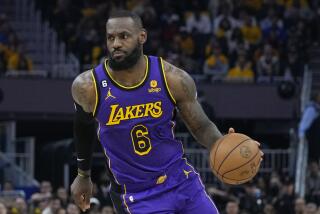How basketball became three-dimensional
Whenever a three-point basket brings a crowd to its feet or swings the momentum in a basketball game, Bill Sharman remembers an old friend.
Abe Saperstein, an energetic promoter best remembered as the founder of the Harlem Globetrotters, introduced the three-point shot to professional basketball as founder of the short-lived American Basketball League, which launched in 1961, crowned only one champion and lasted barely 1 1/2 seasons.
Saperstein, however, did not unveil the innovation that would revolutionize the sport, Sharman says, until first consulting with Sharman and eliciting an enthusiastic thumbs up from the former USC and Boston Celtics star, one of the NBA’s first great shooting guards and an unflinching proponent.
“I thought it was great because I was an outside shooter,” the 81-year-old former Lakers coach said during an interview at his home in Redondo Beach. “He thought it was going to be as popular as the home run.”
Saperstein and Sharman first met when the USC All-American played for a college all-star team that toured with the Globetrotters after the 1949-50 season.
Their friendship grew during Sharman’s 11-year NBA career, when NBA teams and the Globetrotters often paired for attendance-boosting doubleheaders and, in the last half of Sharman’s career, the Celtics were the NBA’s best team.
“We were close,” Sharman said.
So Sharman heard all about it when Saperstein was denied an NBA franchise in Los Angeles, as he believed he’d been promised after helping prop up the league, and owner Bob Short instead moved the Lakers from Minneapolis.
An angry Saperstein reacted by starting his own league, enlisting help from a group of others that included a young George Steinbrenner, owner of the Amateur Athletic Union national champion Cleveland Pipers.
Sharman, an eight-time NBA All-Star who retired as a player after the 1960-61 season, was hired to coach the ABL’s Los Angeles Jets.
Saperstein told him about his plan for a three-point shot.
“He wanted to call it the 25-foot home run,” Sharman said. “He was such a great promoter. He said, ‘When the fans see this, they’ll think it’s one of the best things in basketball.’ And I think he might be right. It’s one of the most fun.”
Sharman, though, told him 25 feet was too far out.
“It’s farther than it looks,” said Sharman, who joined Saperstein in a gym and, after attempting a number of shots from that distance, suggested the three-point arc be painted 25 feet from the back of the rim, rather than the front.
The compromise, Sharman says, put the arc at about the same distance from the basket as it is in the NBA today: 23 feet 9 inches, 22 feet in the corners.
As a coach, Sharman was quick to embrace the shot.
“I didn’t emphasize it that much,” he says, “but I told the players, ‘If you have time to really get set, take it.’ I would say we had two or three plays where we’d set a double pick with a man coming behind it, hoping he would have more time to get set because it’s not a shot you can rush.”
Midway through the season, however, the Jets folded. In Cleveland, where Steinbrenner had made John McClendon the first African American coach of a major pro basketball team, McClendon stepped aside, citing owner meddling. Sharman replaced McClendon and the Pipers won the championship, winning the deciding game, appropriately enough, on a three-point basket by John Barnhill.
Less than a year later, the ABL was gone. The Eastern Professional Basketball League adopted the three-point shot in its 1964-65 season and the success of the American Basketball Assn., which launched in 1967, popularized it.
The NBA, though, didn’t adopt the three-pointer until 1979.
“The NBA didn’t want to promote anything the ABA had done,” Sharman said. “They didn’t want to look like copycats.”
After the ABL, Sharman coached two seasons at Cal State Los Angeles without the three-point shot, which was briefly tested in college basketball as early as 1945 but wasn’t added permanently until 1986, and two with the NBA’s San Francisco Warriors before coaching in the ABA, where he was reintroduced to the three.
“I really thought it added to the game,” he said. “I didn’t feel like I was in a position to push for it, but I sure would give my opinion if anyone asked.”
Saperstein died in 1966, but his innovation lives on.
Nearly 45,000 three-point shots were attempted in NBA games this season, an average of about 36 a game and almost 40,000 more than were put up in the 1979-80 season, when the rule was adopted. About 13 a game were successful.
“It’s like a magnet out there,” the Lakers’ Jordan Farmar says of the three-point arc. “You know you’re a good shooter, so you want to be rewarded.”
Farmar, who launched more three-pointers than any Laker other than Kobe Bryant this season, says the long-range shots are counterintuitive to fundamental basketball -- “The closer you get to the hole, the higher the percentages” -- but acknowledges that they’re a “valuable weapon.”
And, as Saperstein predicted, fans love them.
“I’m sure the game would have survived without three-point shots,” Sharman says. “But it wouldn’t be as popular, nor would the games be as exciting.”
--
More to Read
All things Lakers, all the time.
Get all the Lakers news you need in Dan Woike's weekly newsletter.
You may occasionally receive promotional content from the Los Angeles Times.




